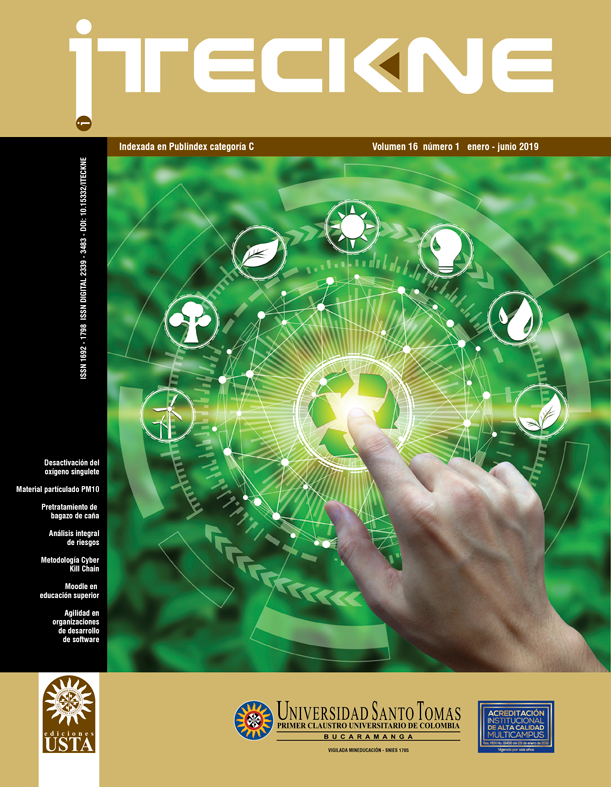Evaluación del desempeño del pretratamiento con peróxido de hidrógeno sobre bagazo de caña de azúcar para remoción de lignina
DOI:
https://doi.org/10.15332/.v16i1.2158Palabras clave:
pretratamiento, biomasa, peróxido de hidrógeno, lignina, bagazo de caña de azúcar, hojarascaResumen
La producción de bioetanol otorga beneficios ambientales, económicos y sociales, reduce la dependencia y preserva las fuentes energéticas fósiles. Esta investigación evaluó el desempeño del pretratamiento químico oxidativo con peróxido de hidrógeno (H2O2) para aumentar la disponibilidad de la celulosa, a partir de mezclas de biomasas lignocelulósicas como bagazo de caña panelero y hojarasca, en proporción (90:10). Fueron evaluadas tres variables (tiempo, temperatura y concentración) utilizando un diseño experimental 23 con triplicado en el punto central, se alcanzó una remoción de lignina del 70% con condiciones de reacción a 60 min, 45°C, 5% de peróxido de hidrógeno. Los resultados obtenidos en la etapa de pretratamiento a 25°C presentaron un buen rendimiento del 88,5% de remoción de lignina soluble y 79,5% de remoción de lignina insoluble a diferentes concentraciones, tales como 7% y 3% de peróxido de hidrógeno, durante un tiempo de 80 y 40 minutos, respectivamente. El diseño experimental identificó las variables significativas del modelo, las cuales fueron el tiempo, la temperatura y la interacción 1*3 que corresponde al tiempo y la concentración, con un 95% de confianza, se trazaron las superficies de respuesta para ver la tendencia de estas interacciones, estableciendo las condiciones óptimas del proceso para reducir costos y tiempo.Descargas
Citas
F. Talebnia, D. Karakashev, and I. Angelidaki, “Production of bioethanol from wheat straw: An overview on pretreatment, hydrolysis,” Bioresour. Technol., vol.101, no. 13, pp. 4744–4753, 2010. https://doi.org/10.1016/j.biortech.2009.11.080
S. Andrea and B. Buttiglione, “Estudios de deslignificación de bagazo de caña de azúcar para su uso en la producción de bioetanol,” tesis, p. 34, 2012. [3] A. M. Sánchez Riaño, A. I. Gutiérrez Morales, J. A. Muñoz Hernández, and C. A. Rivera Barrero, “Producción de bioetanol a partir de subproductos agroindustriales lignocelulósicos Bioethanol Production from agroindustrial lignocellulosic byproducts,” Tumbaga, vol. 5, pp. 61–91, 2010.
J. M. Vargas-barbosa, “Modelo de entrenamiento en toma de decisiones relacionadas con gestión de producción y operaciones de un sistema de fabricación de bioetanol Model training decisions relating to production and operations management system of making bioetanol,” / ITECKNE Vol. 12 Número 1 •, vol. 12, pp. 7–16, 2015. https://doi.org/10.15332/iteckne.v12i1.816
C. Álvarez, “Biocombustibles: desarrollo histórico-tecnológico, mercados actuales y comercio internacional,” Econ. Inf., no. 359, pp. 63–89, 2009.
X. D. Fernandes, S. Pereira, L. Serafim, D. Evtuguin, “Bioethanol,” Bioethanol, pp. 124–152, 2012. https://doi.org/10.5772/850
Y. Sun and J. Cheng, “Hydrolysis of lignocellulosic materials for ethanol production : a review q,” Bioresour. Technol., vol. 83, no. 1, pp. 1–11, 2002.
D. Maria and A. Valencia, “Producción de etanol a partir de bagazo de caña panelera mediante un sistema híbrido de fermentación y pervaporación,” tesis, 2011.
M. J. Taherzadeh and K. Karimi, Enzyme-based hydrolysis processes for ethanol from lignocellulosic materials: A review, vol. 2, no. 4. 2007. https://doi/10.15376/biores.2.4.707-738
Y. Su et al., “Fractional pretreatment of lignocellulose by alkaline hydrogen peroxide: Characterization of its major components,” Food Bioprod. Process., vol. 94, no. April, pp. 322–330, 2015. https://doi/10.1016/j.fbp.2014.04.001
O. lucia Bayona Ayala, “Avaliação De Pré-Tratamentos Para a Hidrólise Enzimática De Palha De Cana-De-Açúcar Considerando a Produção De Etanol,” Universidad Estadual de Campinas, 2012. https://doi.10.1017/CBO9781107415324.004
G. Z. R. Niño López Lilibeth, Acosta Cardenas Alejandro, “Evaluación de pretratamientos químicos para la hidrólisis enzimàtica de residuos lignocelulósicos de yuca (Manihot esculenta Crantz),” Fac. ingenirias la Univ. Antioquia [online], vol. 69, no. 0120–6230, pp.317–326, 2013.
N. Aguilar Rivera, “Bioetanol de la caña de azúcar,” vol. 11, no. 3, pp. 25–39, 2008.
A. Sluiter et al., “Determination of Structural Carbohydrates and Lignin in Biomass Determination of Structural Carbohydrates and Lignin in Biomass,” no. August, 2012.
F. F. De Menezes, G. Jackson, D. M. Rocha, and R. Maciel, “Obtainment and Characterization of Lignin from Enzymatic Hydrolysis of Sugarcane Bagasse of 2G Ethanol Process in Pilot Scale,” vol. 50, pp. 397–402, 2016. https://doi.10.3303/CET1650067
B. A. Behaviour, “Comportamiento de Cenizas y su Impacto en Sistemas de Combustión de Biomasa,” vol. 10, pp. 69–82, 2012.
J. L. Guimarães, E. Frollini, C. G. Silva, F. Wypych, and K. G. Satyanarayana, “Characterization of banana , sugarcane bagasse and sponge gourd fibers of Brazil,” vol. 30, pp. 407–415, 2009.
C. D. E. A. S. L et al., “Obtención de celulosa a partir de residuos agroindustriales de caña de azucar,” pp. 1–7.
Descargas
Publicado
Cómo citar
Número
Sección
Licencia
La revista ITECKNE se encuentra registrada bajo una licencia de Creative Commons Reconocimiento-NoComercial 4.0 Internacional Por lo tanto, esta obra se puede reproducir, distribuir y comunicar públicamente, siempre que se reconozca el nombre de los autores y a la Universidad Santo Tomás. Se permite citar, adaptar, transformar, autoarchivar, republicar y crear a partir del material, siempre que se reconozca adecuadamente la autoría, se proporcione un enlace a la obra original y se indique si se han realizado cambios.
La Revista ITECKNE no retiene los derechos sobre las obras publicadas y los contenidos son responsabilidad exclusiva de los autores, quienes conservan sus derechos morales, intelectuales, de privacidad y publicidad. Sin embargo esta facultada para editar, publicar, reproducir y distribuir tanto en medios impresos como digitales, además de incluir el artículo en índices internacionales y/o bases de datos, de igual manera, se faculta a la editorial para utilizar las imágenes, tablas y/o cualquier material gráfico presentado en el artículo para el diseño de carátulas o posters de la misma revista.













